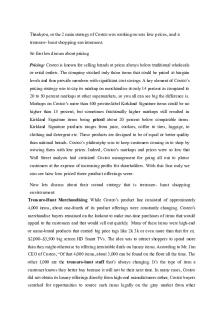Costco Case Study For Brand Management PDF

| Title | Costco Case Study For Brand Management |
|---|---|
| Author | Donald Trump |
| Course | Master in Business Management |
| Institution | Amity University |
| Pages | 2 |
| File Size | 90.1 KB |
| File Type | |
| Total Downloads | 3 |
| Total Views | 174 |
Summary
Costco Case Study For Brand Management...
Description
Thankyou, so the 2 main strategy of Costco was working on was low prices, and a treasure- hunt shopping environment. So first lets discuss about pricing Pricing: Costco is known for selling brands at prices always below traditional wholesale or retail outlets. The company stocked only those items that could be priced at bargain levels and thus provide members with significant cost savings. A key element of Costco’s pricing strategy was to cap its markup on merchandise at only 14 percent as compared to 20 to 50 percent markups at other supermarkets, so you all can see big the difference is. Markups on Costco’s more than 400 private-label Kirkland Signature items could be no higher than 15 percent, but sometimes fractionally higher markups still resulted in Kirkland Signature items being priced about 20 percent below comparable items. Kirkland Signature products ranges from juice, cookies, coffee to tires, luggage, to clothing and detergent etc. These products are designed to be of equal or better quality than national brands. Costco’s philosophy was to keep customers coming in to shop by wowing them with low prices. Indeed, Costco’s markups and prices were so low that Wall Street analysts had criticized Costco management for going all out to please customers at the expense of increasing profits for shareholders. With this line only we can see how low priced there product offerings were. Now lets discuss about their second strategy that is treasure- hunt shopping environment Treasure-Hunt Merchandising: While Costco’s product line consisted of approximately 4,000 items, about one-fourth of its product offerings were constantly changing. Costco’s merchandise buyers remained on the lookout to make one-time purchases of items that would appeal to the customers and that would sell out quickly. Many of these items were high-end or name-brand products that carried big price tags like 2k 3k or even more than that for ex. $2,000–$3,500 big screen HD Smart TVs. The idea was to attract shoppers to spend more than they might otherwise by offering irresistible deals on luxury items. According to Mr. Jim CEO of Costco, “Of that 4,000 items, about 3,000 can be found on the floor all the time. The other 1,000 are the treasure-hunt stuff that’s always changing. It’s the type of item a customer knows they better buy because it will not be their next time. In many cases, Costco did not obtain its luxury offerings directly from high-end manufacturers rather, Costco buyers searched for opportunities to source such items legally on the gray market from other
wholesalers. So, these 2 are the strategy Costco were working on. Marketing and Advertising: Costco’s low prices and its reputation for treasure-hunt shopping made it unnecessary for the company to engage in extensive advertising or sales campaigns. Marketing and promotional activities were generally limited to direct mail programs. Direct mail marketing to prospective new members, and special campaigns for new warehouse openings. For new warehouse openings, marketing teams personally contacted wholesale members; these were contacted with direct e-mailings during the period immediately prior to opening. Management believed that its emphasis on direct mail advertising kept its marketing expenses low relative to those at typical retailers, and supermarkets. Growth Strategy: In recent years, Costco had opened an average 20–25 locations annually; most were in the United States, but expansion was under way internationally as well. The company opened 68 new warehouses in the United States in fiscal years 2002– 2006; 16 new warehouses opened in the first four months of fiscal 2007 and management planned to open another 20–24 by the end of fiscal 2007. Going into 2007, Costco had a total of 102 warehouses in operation outside the United States, including 70 in Canada, 18 in the United Kingdom, 5 in Korea, 5 in Japan, and 4 in Taiwan. Costco was a 50–50 partner in a venture to operate 30 Costco warehouses in Mexico. Web Site Sales: Costco operated two Web sites— www.costco.com in the United States and www.costco.ca in Canada—both to provide another shopping alternative for members and to provide members with a way to purchase products and services that might not be available at the warehouse where they shopped. Thank you...
Similar Free PDFs

Costco Case study 2019
- 3 Pages

Costco Case Study
- 8 Pages

Costco - case study
- 2 Pages

Brand Management Case 1
- 5 Pages

Costco - case
- 1 Pages

Brand management
- 6 Pages

brand management
- 88 Pages

Costco (14) - case
- 1 Pages
Popular Institutions
- Tinajero National High School - Annex
- Politeknik Caltex Riau
- Yokohama City University
- SGT University
- University of Al-Qadisiyah
- Divine Word College of Vigan
- Techniek College Rotterdam
- Universidade de Santiago
- Universiti Teknologi MARA Cawangan Johor Kampus Pasir Gudang
- Poltekkes Kemenkes Yogyakarta
- Baguio City National High School
- Colegio san marcos
- preparatoria uno
- Centro de Bachillerato Tecnológico Industrial y de Servicios No. 107
- Dalian Maritime University
- Quang Trung Secondary School
- Colegio Tecnológico en Informática
- Corporación Regional de Educación Superior
- Grupo CEDVA
- Dar Al Uloom University
- Centro de Estudios Preuniversitarios de la Universidad Nacional de Ingeniería
- 上智大学
- Aakash International School, Nuna Majara
- San Felipe Neri Catholic School
- Kang Chiao International School - New Taipei City
- Misamis Occidental National High School
- Institución Educativa Escuela Normal Juan Ladrilleros
- Kolehiyo ng Pantukan
- Batanes State College
- Instituto Continental
- Sekolah Menengah Kejuruan Kesehatan Kaltara (Tarakan)
- Colegio de La Inmaculada Concepcion - Cebu







